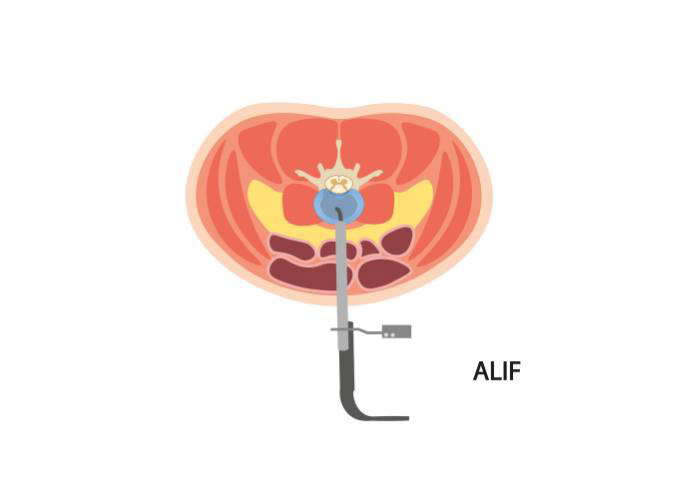ALIF Surgeon
Lower back pain, caused by a disc, or degenerative vertebra may be helped by a procedure called anterior lumbar interbody fusion, or ALIF. This procedure is done through an incision In the abdomen and can help patients in Clear Lake, Houston and Sugar Land, Texas who have been unable to escape their low-back pain. Dr. Andre Samuel specializes in ALIF and can help you. Contact his office to discuss your treatment options.

What is anterior lumbar interbody fusion (ALIF)?
Spinal fusion is a surgical procedure used to fuse, or permanently lock together two or more vertebrae. An anterior lumbar interbody fusion (ALIF) is done in the lower back (lumbar region), where the incision site occurs in the front of the body (anterior) through a small incision in the abdomen. The term “interbody” means the intervertebral disc is removed and replaced with bone or metal as a spacer. The spacer corrects the spinal curvature and becomes a bridge between the two vertebrae to promote fusion. ALIF is often done for multiple vertebrae and is used to treat lower back pain often associated with lumbar degenerative disc disease or spondylolisthesis (a “slipped” disc). Doctor Andre M. Samuel, Orthopedic Spine Surgeon, treats patients in Clear Lake, Houston and Sugar Land areas who are suffering from back pain and need an anterior lumbar interbody fusion.

When should someone have an anterior lumbar interbody fusion or ALIF Surgery?
ALIF is often suggested by Dr. Samuel when the spine is unstable, or when treating a failed posterior fusion. ALIF may also be suggested for multi-level fusion and disc removal, lumbosacral fusion, or a single degenerative disc with disc-space collapse. The anterior approach is usually combined with a posterior approach, where the doctor’s incision to access the vertebra occurs in the lower back. If the spine is unstable more rigid fixation, such as posterior screws, may be added.
How is anterior lumbar interbody fusion (ALIF) surgery done?
Fusion surgery usually requires an in-patient say at the hospital after surgery. During this specialized procedure, Dr. Samuel makes a small incision in the abdomen, near the belly button. The abdominal muscles, intestine and blood vessels are carefully moved aside so Dr. Samuel can visualize the vertebra. He confirms the correct location for the fusion with an x-ray, then the diseased disc is removed. A patient-specific-sized disc (made of either bone, plastic or metal) is placed in the disc space. After another x-ray that confirms position, the implant is then secured into position with surgical screws, metal plates or a spinal cage. These materials promote fusion of the vertebra. Surgical tools are then removed and the incision is sutured closed.
How long is the recovery after ALIF?
Each patient recovers differently based on the procedure performed, underlying conditions, and overall health of the patient. In general, patients undergoing ALIF surgery can expect the following:
- The patient will stay in the hospital overnight and up to 3 days, or longer if a posterior fusion was performed at the same time.
- Pain medication will be administered and is to be used only as directed.
- Most patients will stand and/or walk the same day or the day after surgery.
- Patients should avoid lifting heavy objects, bending or twisting for several weeks.
- A specialized physical therapy program will be prescribed to strengthen weakened muscles in the back.
When will I be out of pain after ALIF?
The patient’s back and abdomen will be sore for 3-4 weeks following surgery. Gradually the pain will decrease, with most patients experience a lessening in lower back pain 4-5 weeks after surgery. Normal activities can usually be resumed in 3 months.



